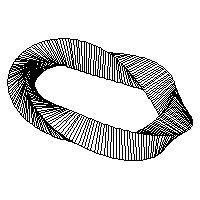Mobius Spider Seating
The Mobius is a mathematical construction with unique architectural
properties; the transformation of a simple plane by a simple twist,
at once representing a floor, then an outside wall, then a ceiling,
and finally an inside wall. The many faces of one surface.
To better understand the
properties of this construction, a series of models were developed as
a prototype for outdoor seating. An one-half twist and an one-and-one-half
twist Mobius is investigated, in the form of a band and a three-sided
prism. The goal was to determine if the concept of a nonconstant twist
could introduce flat sections for seating and if the arrangement of
flat and twisted sections could make the seating self-supporting and
further self-evident of function.
The series presented here includes one hundred and twenty-four variations
of flat and twisted forms. A series of section angle combinations are
explored following both elliptical and circular paths.
The first series include a smooth band and a smooth prism. Each are
represented as continuous surfaces with no differentiation for the seating
sections and nonseating sections except for the twist itself. The third
series separates the band version into individual slats to differentiate
the seating section from the twisting section by varying the dimension
of the inner series of slats. A fourth series as shown in the rapid
prototype models is of the prism. It is separated into individual sections
and alternating sizes are varied through the twisting sections.
The last two were named spiders because the individual sections recall
spider legs; somewhat appropriate for outdoor seating. A danger is introduced
through the twist, due to the projecting slats, adding to the spider
concept and giving the form a natural self-evidence of function; where
you should sit and where you should not sit. The prism version, found
in the rapid prototype models, uses pointed triangular sections to achieve
the same effect.
All of these models were developed with custom software within Autodesk's
AutoCAD system using the AutoLisp programming language. A simple coding
scheme was developed to determine the flat and twisting sections. The
plaster rapid prototype models were fabricated on Z-Corp equipment.
The interactive viewer is LiveGraphics3D 1.30 developed by Martin Kraus
using the Mathamatica modeling format. |







